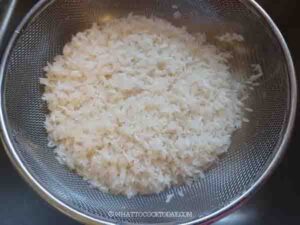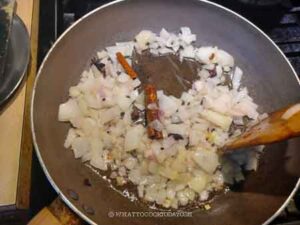This post may contain affiliate links. Please read our disclosure policy.
Nasi Minyak Palembang is the perfect blend of Middle Eastern spice and Indonesian creativity. Its rich flavors, luxurious texture, and cultural significance make it a must-try for anyone looking to explore the diversity of Southeast Asian cuisine. The recipe can be cooked using a pressure cooker, rice cooker, or on the stove.

What is nasi minyak or nasi samin ?
Nasi Minyak, also known as Nasi Samin, is a rich and fragrant rice dish with Middle Eastern roots that has become a beloved part of Indonesian and Malaysian cuisine. It is known as nasi minyak in Malaysia. In Palembang, Indonesia, this dish is a celebration of spices, often served at special occasions such as weddings and family gatherings. Its name, which translates to “oily rice,” refers to the ghee (clarified butter), also known as samin, that gives the rice its signature richness and aroma.
While the dish draws from Middle Eastern influences, it has been adapted over generations, with ingredients reflecting the region’s abundant produce and local tastes. The version from Indonesia, particularly Palembang, is notable for its luxurious use of milk, fragrant spices, and often served with pineapple sambal and malbi sapi.
Nasi Minyak/Nasi Samin Palembang (Ghee Spiced Rice)
Ingredients
- 500 g basmati rice
- 40 g ghee
- 1 large onion diced
- 5 shallots diced
- 5 cloves garlic minced
- 1 large tomato seeded and diced
- 1 Tbsp tomato paste
- 250 ml whole milk
- 200 ml water
Spices:
- 1 large cinnamon stick
- 5 white cardamom pods leave them whole
- 3 cloves
- 2 star anise
- ¼ tsp fennel seeds
- 1 Tbsp curry powder
- ½ tsp ground nutmeg
Seasonings:
- 1 tsp salt
- ½ tsp ground white pepper
Garnish:
- Cilantro leaves
Pineapple sambal:
- 200 g pineapple cut into small cubes
- 3 Tbsp sambal oelek I use store-bought
- 1 tsp sugar
- ¼ tsp salt or more to taste
Instructions
- Rinse the rice in several changes of water until the water runs clear. Drain off the water completely

If cooking on Instant Pot pressure cooker:
- Press saute on instant pot and when it says "hot", add the ghee and let it melt. Add diced onion, shallots and garlic and saute for about 3 minutes until fragrant. Add all the spices and saute for another 2 minutes until fragrant
- Add the rice, salt, and ground pepper and stir to mix the rice with the aromatics and spices. Add the milk and water and stir again to make sure the rice is submerged in the liquid. Turn off the saute mode. Make sure you scrape the bottom of the pot really well with wooden spatula to make sure nothing is stuck to the bottom of the pot because it can trigger the "burn" alert
- Cover with the lid. Turn the pressure release valve to "sealing". Press "rice" and the time is automatically set to 12 minutes and it will be on low pressure by default. When the rice is done cooking, do a natural release, which takes about 10-15 minutes
- Unlock the cover and use a rice paddle to fluff the rice. Keep the rice warm using the warm function until it is ready to be served. Garnish with cilantro leaves just before serving
If cooking with rice cooker:
- In a large heavy-bottom skillet or pot, add ghee and let it melt over medium heat. Add diced onion, shallots and garlic and saute for about 3 minutes until fragrant.

- Add all the spices and tomatoes and saute for another 2 minutes until fragrant

- Add the rice, salt, and ground pepper and stir to mix the rice with the aromatics and spices. Stir until combined. Remove the skillet or pot from the stove. Transfer the rice mixture to the inner pot of the rice cooker

- Add milk and water to the rice mixture. Give the mixture a stir. Close the lid of the rice cooker and press cook on your rice cooker or whatever setting you usually use to cook a white rice

- When the rice is done cooking, wait 10 minutes before you open the lid of the rice cooker. Fluff the rice using the rice paddle. Keep it warm in the rice cooker until it is ready to be served. Garnish with cilantro leaves just before serving

If cooking on the stove:
- Use a heavy-bottom skillet or pot that comes with a lid. Add ghee and let it melt over medium heat. Add diced onion, shallots and garlic and saute for about 3 minutes until fragrant. Add all the spices and saute for another 2 minutes until fragrant
- Add the rice, salt, and ground pepper and stir to mix the rice with the aromatics and spices. Stir until combined. Add the milk and water and stir to mix everything. Scrape the bottom of the skillet/pot to make sure nothing catches at the bottom of the skillet/pot. Bring the mixture to a gentle simmer and then cover with a lid. Let it cook for about 15 minutes over medium-low heat.Then turn off the heat but DO NOT open the lid. Let it sit for 10 minutes
- Then uncover the lid and fluff the rice. It is ready to be served with other dishes. Garnish with cilantro leaves
Prepare the pineapple sambal:
- Combine the pineapple, sambal oelek, sugar, and salt. Simply mix to combine everything. The sambal can be kept in the fridge for up to one week
To serve:
- Serve the rice with the pineapple sambal on the side. Usually this dish is served with malbi sapi, but you can serve it with any other meat, poultry dishes or whatever you like
RECOMMEDED TOOLS
*Nutrition facts are just estimates and calculated using online tools*

Ingredients of nasi minyak/nasi samin
Rice: The main base, typically long-grain rice. Use basmati rice for the best texture
Ghee (Samin): Infuses the dish with rich, buttery flavor.
Milk: Adds creaminess to the rice.
Onion, Shallots, Garlic: These aromatics provide a savory depth.
Tomato and Tomato Paste: For acidity and slightly reddish color
Spices: A blend of curry powder, nutmeg, cinnamon, star anise, cardamom, cloves, fennel seeds, salt, and ground white pepper creates a bold, warming flavor.
Tips
Rice Variety: Use long-grain rice like basmati for the best texture.
Spice Balance: Adjust the amount of spices depending on your preference. The dish should be aromatic but not overwhelming.
Ghee Substitute: If you don’t have ghee, butter can be used, though the flavor will be slightly different.











2 comments
Where does the pineapple sembal fit in, I cannot figure out where and when to put it in? Thank you,
You serve the rice with the sambal on the side.